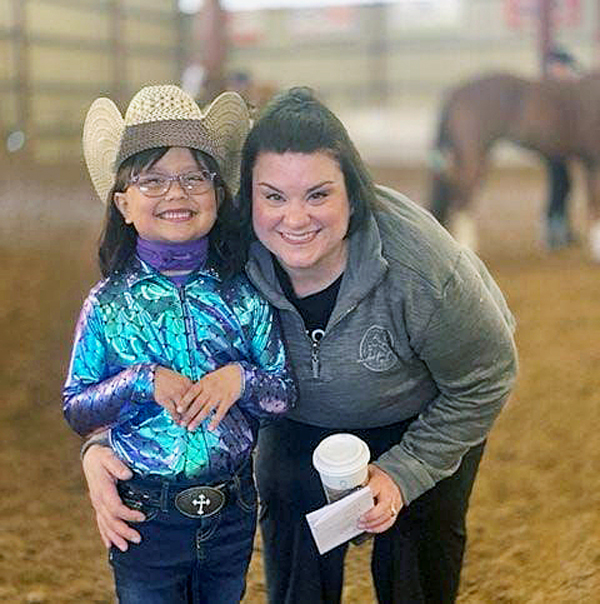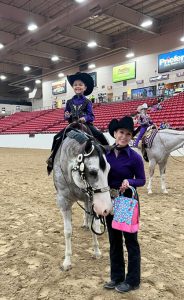Youth Are The Future
I can still remember my first open show at age 7. I slept in my show clothes because I was so afraid, I would not wake up in time, only to not sleep a single minute that night from sheer excitement. My mom French braided my hair so tight, that it hurt to think and blink. She said it would help me keep my eyes open. LOL. I don’t remember the placings, or if my pony gave me good rides. I don’t remember being tired, or even the classes I entered. I do, however, remember those feelings of excitement and joy leading up to my first show. This is what I want for my own child! I want her to find happiness in this amazing adventure and sport.
I was a blessed kid, whose parents were not wealthy people, but who wanted to give me something they had never had. A horse, and the opportunity to ride. While it was my mother who got me into 4H and horse showing, I am POSITIVE, she did not realize that she was setting me on a course to be a lifetime competitive equestrian and horse show enthusiast. Well, mom, here I am. I hope I NEVER lose the sparkle of pleasure that horse shows bring to my life. Thank you for helping me find this community of people.
As I sit and think about my own journey as a competitive equestrian, I can’t help but see so many
differences for the kids around me. Are those carefree days gone? You know the ones, spending all day at the barn with a sack lunch, riding, laughing, cleaning stalls, riding some more and having a genuinely awesome time. Being empowered and nurtured by adult equestrians in your barn to learn more and join into associations or groups that hosted regional shows. My parents may have lit the flame, but my competitive equestrian candle burned bright because of the welcome, and supportive nurturing I received from the adult equestrians around me.
The overall decline of youth participation within horse industry is a big problem. This decline is the topic of meetings, and a priority of many national committees throughout the breed associations within the industry. Everyone wants to know how to fix it. How can we grow our youth numbers? How can we infuse new people into the associations and industry? How can we give opportunity to kids?
I don’t have the answer. It is a million-dollar question, with many prongs and tiers. I can offer perspective, however, and share my thoughts as a parent of a youth exhibitor. If the industry that I love so much is going to continue into the future, engaging youth is a necessity. If we are going to actually, and sustainably grow our youth, we will have to change our practices, and as we all know…. change is not a favored thing.
Growing our youth starts with partnerships. Horse breed associations must engage in thoughtful and purposeful partnership with outside entities, if we are to reach youth and nurture them into our breed association folds. Our youth deserve the right to help shape the industry they are a part of. In 2012, the Society for Community Research and Action published an article on the psychology and practice of youth and adult partnerships. The articles outline four core elements of youth and adult partnerships.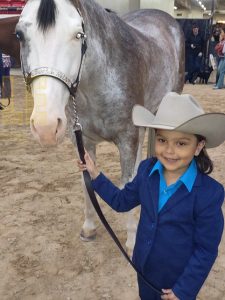
- Authentic Decision Making. Associations MUST allow youth to actively participate in a way where they are the center of the collective decision making for things that impact them. This requires more than surface level involvement where youth are invited into conversations or situations where their wishes and/or ideas are voiced but not heard. Maybe we need to include youth advisors for each state, province, country or region in our national associations in a way that allows them to actually vote on rules or proposals that will impact them. They need to be given the opportunity to actively participate in their own future and experiences. This is also a way to bring unhorsed youth into our folds. Did you know that the opportunity of participation in decision making and taking on leadership roles have been found to attract and retain low-income and youth of color in community programs? We can look for collaboration opportunities with programs such as Detroit Horsepower and We Ride too in Oakland, California. This is an easy and amazing way to add diversity to our associations!
- Natural Mentorship. Kids know when an adult is interested in what they have to say. They know when someone is just giving them “lip service.” Kids know who to go to for help, and who doesn’t have the time, or who won’t make the time for them. Those adults who are willing to work collaboratively with youth become known as “partners, or allies.” In a New York study, youth participants reported the desire to work with adults who are non-judgmental, passionate, and well organized. A National League of Cities study (2010) found that ‘‘adult partners must be able to empower without abdicating, support without taking over, and encourage without preaching.’’ Natural mentors can help youth focus on their future, and in the face of adversity can offer support as successful professional and educational role models. This is yet another way to bring unhorsed youth into our associations. Practices where mentoring relationships based on adults having a high degree of control, fail to engage youth and often lead to discontent with an increasing level of disengagement. It is time to rethink our association practices for inclusion of youth voices.
- Reciprocal Activity. The development of youth and empowerment is only enhanced under conditions of reciprocity. This is particularly true when youth believe that they have contributed to others, and when the balance of power progressively shifts toward the youth. This reciprocity happens when the youth are able to share in a way that their life experiences have been validated by an association or industry. Everyone has the potential to share experiences which bring value to the overall equestrian experience. This is yet another way for all youth, no matter if they own a horse or not, to get involved.
- Community Connectedness. The connections formed through partnership can translate into opportunities for scholarships, awards, internships, and employment among youth. The elements of peer relationships, the work being done, and the feeling of being part of something larger result in strong feelings of group solidarity and membership. There are also positive changes in adult perceptions of youth. Sharing successes with youth has been found to enhance adult partners and reinforce the collective purposes, which also lead to feelings of organizational membership and commitment to the association or industry. The opportunities for youth are many and can easily include youth who do not own horses.
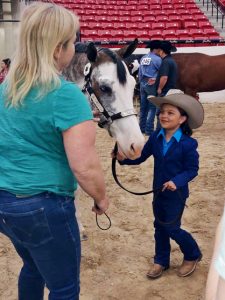 Horse showing is expensive. It is a fact. It is also a fact that without the fees paid by the exhibitors, and the money given by the sponsors, the individual associations, regional clubs, groups, or even individuals, can’t host events for exhibitors to show at. There will always be a debate about the costs associated with horse ownership and showing. Not everyone can afford to go there. We all know this. So, instead of focusing on those factors, what can we do to encourage increased levels of participation? There are only so many things we can control, so what is within the realm of control on a regional or even national level that will allow for increased levels of participation of youth?
Horse showing is expensive. It is a fact. It is also a fact that without the fees paid by the exhibitors, and the money given by the sponsors, the individual associations, regional clubs, groups, or even individuals, can’t host events for exhibitors to show at. There will always be a debate about the costs associated with horse ownership and showing. Not everyone can afford to go there. We all know this. So, instead of focusing on those factors, what can we do to encourage increased levels of participation? There are only so many things we can control, so what is within the realm of control on a regional or even national level that will allow for increased levels of participation of youth?
It costs nothing to be inviting and to be nice to people. It cost nothing to embrace the young people who come to our events as children of exhibitors, or friends of exhibitors. Can educational experiences be expanded at our regional and national level shows that would invite in youth? If we are to grow as an industry, we can’t look only to increasing the youth who are showing. That narrow sightedness will cause us to miss the boat and remain on the dock each time. There are exponentially more youth who are not current riders than there are who ride. What can our associations offer to the unhorsed youth?
The metrics used to report growth of youth within any equine breed association seems to only come in two forms. They are tracked by national memberships, and by horse show entries. As leaders within the larger equestrian industry, horse show entries may be harder to influence, however, increasing national membership could potentially be much easier to leverage. We can positively influence our national breed association membership numbers by making commitments to change and putting our time and energy into the development of programs that will allow access to anyone and everyone.
What do the youth want? Have we actually asked them? Not only have we asked them, but have we actually listened to what they have said? From my perspective, I see an industry of hardworking and good intentioned people who are working in isolation toward a common goal. I see a lot of adults working hard to propose ideas that they think will help support the kids, but how many of those ideas have been vetted by the youth who are impacted?
The lack of youth participation is not felt by only one group. It is a systemic issue that needs to be addressed. Without youth, our events will dry up. I personally, feel that there is no time like the present to start talking with kids who show, and who have no idea what a horse association is, but who just like horses. I feel that beyond talking to these youth, we need to LISTEN to what they are saying and move forward with changes that will allow for meaningful and positive collaboration for all of our future successes. I feel that youth need representation that is more than just a title given. Those elected representatives need to be included at the big kids table and need to have a voice in the things that impact them.
I feel that the adults need to set aside personal agendas and defer to the voice of the youth, on youth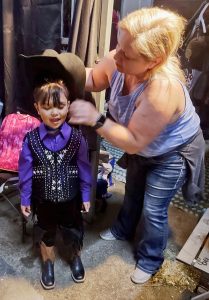 related topics. I say this without intending disrespect to anyone. We can’t stand on our soap boxes and make priority over priority related to increasing youth participation, but then fail to implement changes that could actually yield that growth. Not every youth participant will show a horse, but a youth participant may go on to become a horse show judge, or show manager, or show secretary. Are there national apprenticeship programs that allow kids to explore those jobs and/or do some job shadowing? It is entirely possible that the youth bring ideas that the adults may not agree with, but that doesn’t mean those ideas are not valuable and/or shouldn’t be advanced. Part our job as adults is to show the youth that it is okay to try new things and to make mistakes.
related topics. I say this without intending disrespect to anyone. We can’t stand on our soap boxes and make priority over priority related to increasing youth participation, but then fail to implement changes that could actually yield that growth. Not every youth participant will show a horse, but a youth participant may go on to become a horse show judge, or show manager, or show secretary. Are there national apprenticeship programs that allow kids to explore those jobs and/or do some job shadowing? It is entirely possible that the youth bring ideas that the adults may not agree with, but that doesn’t mean those ideas are not valuable and/or shouldn’t be advanced. Part our job as adults is to show the youth that it is okay to try new things and to make mistakes.
Partnerships are key to our survival and future successes. Partnerships come in many different forms. Partnerships should be welcomed and embraced. There are horse crazy kids out there, who may never get on the back of a horse. Those youth have the potential to contribute amazing and powerful insight to our industry. At the end of the day, the youth are our future, and our most valuable resource. It is time to harness that resource.
This work is hard. This work takes time. When I reflect upon my own experiences and compare that to what my daughter is being able to experience, I can’t help but see differences. She mirrors that same excitement, and inability to sleep going into a show. She would rather spend all day at a horse show with her friends and aunties than stay home with her toys. I love that she loves this as much as I do. I want so badly for her to be able to grow that childhood love of horses and showing into adulthood. We need these youth! We need to get them excited! We need to offer them ways to engage in a variety of manners with our breed associations. All the well-meaning adults in the world can’t continue an association forever. That will take youth, and growing youth from a young age. It is time to make them feel like they are important. It is time to not just give them a voice, but to listen to that voice. The youth of today, my friends, are the leaders of tomorrow.
Very Respectfully,
Kory Kumar










